Five years after an ambitious redevelopment project began, property values in Uptown are the fastest-growing in Memphis. But even the area’s developers were surprised when property values started to rise almost as soon as the project began.
“We didn’t realize how quickly our improvements would affect our work,” says Alex Mobley, vice president of Uptown’s community development company. “By buying land and reusing it, it raised property values so high, so quickly, that several times we ran out of money.”
Though it slowed their work, it also meant that other people in the city were, quite literally, buying into the Uptown project.
Using tax increment financing and a $35 million federal Hope VI grant, developers Jack Belz and Henry Turley teamed up with the city of Memphis in 2002 to revitalize the area just east of Harbor Town. The result was a 100-block mixed-income neighborhood that Turley calls “revitalization without gentrification.”
“The focus isn’t on tearing everything down, but infilling vacant lots while leaving the habitable homes and apartments in place and ultimately bettering them,” Turley says.
Memphis Housing and Community Development director Robert Lipscomb compares the project to rebuilding a small city.
“When I first got to HCD, our public housing was horrible. It was embarrassing for a city this size to have people living in those conditions,” Lipscomb says.
After being denied a Hope VI grant for the Hurt Village housing project, the city reapplied with a broader plan in mind. “Why not include Lauderdale Courts in the project and make it the whole area stretching from there to Hurt Village?” Lipscomb says. “People looked at us like, you’re going to do what?”
The city began revitalization by acquiring abandoned and vacant lots in what was then known as Greenlaw and hiring Belz and Turley to redevelop them. Hurt Village was demolished and a walkable, mixed-income community planned in its place.
Mobley began working with the Uptown project in 2003, during the demolition phase. “I thought to myself, this is going to be a lot of work,” she says.
In 2005, the Metropolitan apartments opened with great fanfare, and former residents of Hurt Village were among some of the first tenants.
“Once people started moving in, the change was incredible,” Mobley says. “Every month you would see enormous improvement.”
Every new home is built to MLGW EcoBUILD standards, saving residents roughly 35 percent on their electric bills and 55 percent on gas bills. Using the Hope VI program, prospective homebuyers can qualify for an interest-free forgivable grant that is reduced 10 percent per year for 10 years.
“It hasn’t been a real moneymaker from our standpoint,” Belz says about the Uptown project, “but it’s been a worthwhile contribution to the continued revitalization of downtown Memphis.”
With the initial phases complete, 5,000 new residents are sharing chili cook-offs, progressive dinners, and touch football games with longtime residents of the oldest suburb in Memphis. A commercial development also is planned near Auction and Danny Thomas.
But, as the neighborhood transitions to self-sustainability, it still faces challenges. The project initially met with skepticism and distrust, and some of that lingers. Turley cites crime, public schools, and blight as areas that need improvement, and he also wants to find a way to help longtime residents improve their property.
“What has been called the new neighborhood and the old neighborhood … we’d like to blur that distinction in the coming year,” he says.
And though part of the project was an anti-blight initiative, the Uptown area still has pockets of blight.
“It’s challenging, but the end result will far outweigh the difficulty,” Mobley says. “Once you meet the people who live there now and the people who have lived there for years, it makes it all worthwhile.”
 Justin Fox Burks
Justin Fox Burks
Grace Church, pastored by Jordan Thomas, Bryan Smith, and Nathan Sawyer, holds services at Bridges.
Early Adopters
Rich Bullington and Kaleigh Donnelly moved their family to Uptown after being pioneers in Cooper-Young.
While Rich Bullington and Kaleigh Donnelly were building their new house, it got the neighbors talking.
“There was a rumor going around that this house was being built as auxiliary patient housing for St. Jude,” Donnelly says.
The neighborhood can perhaps be forgiven for assuming — somewhat correctly — that the research hospital was involved. Donnelly works in St. Jude’s food-service division and likes the complex’s signature coral color so much, she decided to use it on her house, too.
“[The builder’s decorator] went to St. Jude with her little paint-chip book and went up to a wall,” Donnelly says. “Security was like, I don’t know if we’re going to let you in, and she says, please, I just want to match the paint.”
It was raining that day, so Donnelly calls her house’s color “wet St. Jude.” Officially, however, the color is “mellow coral.”
Donnelly and Bullington are early adopters when it comes to burgeoning communities. When the family bought in Uptown, the neighborhood was nothing but dirt. And their first home together was in a then-sleepy Cooper-Young.
“We bought our house [in Cooper-Young] in the spring of ’93. There was nothing there, just Java Cabana and Café Ole and that was it,” Donnelly says. “We just knew we were making a good investment. My parents thought we were crazy.”
After moving in, the couple didn’t think they would ever move out of Cooper-Young. But they say it got to a point where one bathroom wasn’t enough for the family of four.
“Honestly, that was a big part of it,” Donnelly says. “The house was built in 1935, and there’s only so much you can do to improve it without taking the character away. We didn’t want to do that, but we needed more house.”
One day, while the family wrangled over the bathroom, Bullington remarked that they needed a bigger house. Later on that day, Donnelly called him and told him she had found their new house. It wasn’t built yet, but she had found it.
Now they have 1,800 square feet, three and a half bathrooms, central air, and enough electrical outlets so they don’t have to plug surge protectors into surge protectors for all their electrical appliances.
Though Donnelly didn’t work at St. Jude when the family decided to move to Uptown, having a job close to home is a big plus. It takes her about 15 minutes to walk to work each morning.
The family doesn’t consider themselves “tree-huggers,” but between the walkability and the sustainable materials used to build the house, it all made sense.
“Before we got married, I wanted to live downtown and he wanted a house with a yard,” Donnelly says. “This seemed like a way to get downtown and have a house and a yard.”
Now they hope that Uptown will be just as good an investment as Cooper-Young was.
“My parents ate their words,” Donnelly says. “Now they totally trust my judgment on real estate decisions. They’re like, Uptown? Looks brilliant. Do what you’ve got to do.”
 Justin Fox Burks
Justin Fox Burks
Grace Church, pastored by Jordan Thomas, Bryan Smith, and Nathan Sawyer, holds services at Bridges.
The Prodigal Son
 Justin Fox Burks
Justin Fox Burks
The Donnelly-Bullington family moved to Uptown from Cooper-Young.
For Tory Parks, it’s not just real estate; it’s home.
When Tory Parks began renovating the apartment building at 241 Mill, he decided to rent the units instead of selling them as condos.
“It’s my history, so it’s not for sale,” Parks says.
Members of Parks’ family have lived in the building since 1905. He grew up there with his mother. His great-grandmother and two aunts lived there, as did his grandparents. In fact, after his grandparents split up, they continued to live there, in two different apartments next door to each other. But in the 1980s, the family began to move out of Greenlaw.
“My grandmother was the last of our family to live here. Drug dealers moved next door, so I bought it, gutted it, and started over,” he says.
Parks graduated from Central High School and got his criminal justice degree from Southwest Tennesse Community College. But about 10 years ago, he started renovating property.
“When I got into it, I just wanted to perfect it. I’d fix one up and do it again until I got it right,” Parks says.
For Jennifer Place — named after his mother — the style is “New Orleans” on the outside and “Bahamas” on the inside. He included a graceful arch in the living rooms and each of the bottom-floor units has a private garden in the back.
On a mild September morning a week before the grand opening, Parks sits on the building’s steps. Passing motorists and pedestrians say hello as they pass.
In a way, Parks is a bridge between Greenlaw and Uptown — what was and what could be.
“There was a little bit of distrust because of the way the development moved in. You’re trying to police people you didn’t want to police at first,” he says. “People would get killed in this neighborhood when I was growing up, and it wouldn’t even make the news. It was like it wasn’t important.”
Now, he says, anyone should be able to see the area’s redevelopment was a good thing for everybody.
“We’re taking back the community. The number of bad people who still live in the community is low, and the number of good people is high,” Parks says. “After awhile, you’re going to have to get with it or leave.”
Parks bought the apartment building for $37,000 in 1997, and, though its value has appreciated since then, it hasn’t been an easy road. Two years ago, he was about 80 percent done with the renovation when someone burned down the building.
“That was a critical blow. That took a year of my life away,” he says. Then he thought about his mother, raising four boys on her own, and knew he couldn’t give up.
“I couldn’t let her down. I want to build communities. I’m not just housing people,” he says.
And maybe he’s succeeded. When his grandmother saw a sidewalk in front of the building — something that didn’t exist when she lived there — she burst into tears.
“A lot of people tell me, man, you’ve invested too much. I’m like, I used to live here. You mean to tell me I’m not worth it? This isn’t just real estate. I’m trying to inspire people.”
 Justin Fox Burks
Justin Fox Burks
Grace Church, pastored by Jordan Thomas, Bryan Smith, and Nathan Sawyer, holds services at Bridges.
Single in the City
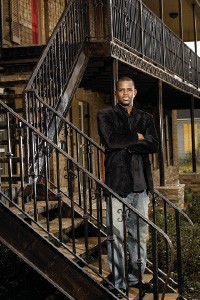 Justin Fox Burks
Justin Fox Burks
Tory Parks has renovated the Uptown apartment building he grew up in.
Jackson, Tennessee, native finds a home that’s just her size.
Charlotte Marshall wanted to buy a house, but hesitated when her realtor suggested Uptown.
“I had looked there years ago, and the houses were all three and four bedrooms,” says the single woman. “I didn’t know they had started building houses with two and three bedrooms, so I initially said no, I don’t need that much room.”
She looked in other areas — Midtown, downtown, East Memphis — but returned to Uptown.
“They had started building houses for single people, not just families,” Marshall says. She found a house that was the right size and reminded her of places she had lived in Maryland and Florida.
“I liked the area,” she says. “It’s not like any other community in town. There are people who have been here 30, 40 years, mixed with people who have just moved in. There are different races. It’s very urban.”
A native of Jackson, Tennessee, Marshall moved to Memphis in 1996 and works in quality assurance for Coca-Cola in West Memphis. She wanted to live close to downtown, and she needed to live close to work. Uptown is about as close to the Hernando DeSoto bridge as one can get.
“It’s close to where the action is,” she says of her house on 5th Street. “Since I’m single, there’s no point in living in the suburbs. That’s for families.”
Being close to the action is one thing, but she’s also in a good spot for physical activity. Marshall goes to a downtown gym, and she also typically runs seven to 10 miles several times a week.
“When I go jogging, I can go through four different neighborhoods in 45 minutes,” she says. “I go to Harbor Town and loop around there, come back down Jackson, go through Overton Park, go down Madison and the medical district. I like that the neighborhoods are so close.”
If other neighborhoods are close, the neighbors are even closer. She knows all the neighbors on her block, and, in November, they had a progressive Thanksgiving dinner. One house had appetizers and drinks, another had the main course, and another had dessert.
“It reminds me of a city that is not so close-minded,” Marshall says. “It’s up-and-coming, and I like that.”
 Justin Fox Burks
Justin Fox Burks
Grace Church, pastored by Jordan Thomas, Bryan Smith, and Nathan Sawyer, holds services at Bridges.
Retail Reworked
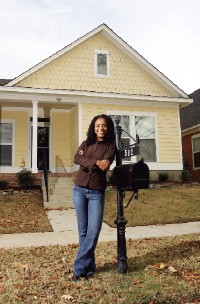 Justin Fox Burks
Justin Fox Burks
Charlotte Marshall in front of her Uptown home
A former University of Memphis architecture student did his homework on Uptown. Literally.
Duke Walker might say he’s going to “the store,” but what he really means is that he’s going home.
Last summer, Walker bought Lee’s Cash and Carry, a 1,500-square-foot grocery store that’s been in the neighborhood since 1936, to renovate it into a modern home.
An Air Force brat, Walker spent his early childhood in England, Turkey, and Spain before his father retired to the family tobacco farm in Virginia. He initially came to Memphis with his wife and worked in construction.
“She had landed a job here, and as a construction worker, I could work anywhere,” Walker says. “When I moved to Memphis, I started living out east. I wasn’t aware of what was going on. I just knew that was where all the construction was. I could bend a lot of nails out there and make some money.”
In the late 1990s, with 20 years in construction and a failed marriage under his tool belt, Walker decided to go back to school to study architecture. It was there that he began looking at urban sprawl and its debilitating effect on the urban core.
“It started grating on me,” he says. “I’ve been supporting this? And in a big way! We’re framing these multi-million dollar-custom houses, and it’s like, I’m helping these people screw up the city.”
For his thesis, Walker studied ways to use derelict land near downtown, spending a lot of time in the neighborhood then known as Greenlaw. He started thinking about reusing and renovating older buildings.
“I guess that’s what I did with myself,” Walker says. “I made use of what I had and remade myself.”
When he got a job with the Hnedak Bobo Group this year, he began to look for a place to live downtown and saw a listing for Lee’s Cash and Carry.
“I thought, I bought a Gatorade in that store when I was working on my thesis. And now it’s for sale,” he says. “It was rezoned residential, and all these little bells were going off. Here it is, Duke. You better jump.”
Some of his friends think he’s crazy, but when he talks about using hidden resources and teaching his teenage children a lesson about conservation, he sounds both rational and incredibly excited.
“I could have bought a house for the same thing I paid for [the store] and not have to do much to it, but I just couldn’t do that,” Walker says. “Knowing that the building was sitting there, and maybe somebody would bulldoze it and build apartments there — nah. It’s a perfectly fine building.”
Renovations are rarely easy. Walker couldn’t get a residential loan for what was essentially still a commercial building, but he couldn’t get a commercial loan on property that didn’t have any commercial use. Instead, he got financing from the former owner.
“This is not just moving into a house,” Walker says. “This is changing the usage and trying to reintegrate this building and this location back to a living/working place again.”
He’d like to keep the “Cash and Carry” sign painted on the side, because he doesn’t want the neighborhood to lose the landmark.
“I want it to say Lee’s Cash and Carry. I want it to be the same thing everybody knows it as, but now Duke lives there instead.”
 Justin Fox Burks
Justin Fox Burks
Grace Church, pastored by Jordan Thomas, Bryan Smith, and Nathan Sawyer, holds services at Bridges.
A Love of Antiques
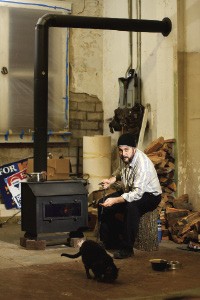 Justin Fox Burks
Justin Fox Burks
Duke Walker at home in a former Uptown grocery store.
Larry Bonds restores old homes in the Uptown area, always looking for a story.
A friend says Larry Bonds is obsessed with old things. But all one has to do is step inside his front door to know that is true. Everything — from the furniture to the light fixtures to the old-fashioned wheelchair that sits near the front door — has a story.
“I use that on the porch,” Bonds says of the wooden wheelchair. “Some kids stole the chairs I had out there. This way, I can roll it in at night.”
Bonds is one of Uptown’s pioneers. After restoring several homes in Midtown with a partner, he began to hear about opportunities in Greenlaw in 2000. That year, he bought the house he and his family now live in for $13,500.
“I remember when downtown was a ghost town, and I had watched [revitalization] happen there. I said, now is the time to buy down here, because if that area did it, this area will do it, too,” Bonds says.
The Mississippi native has renovated seven houses in Uptown and is in the middle of another renovation. He’s fixed up two apartment complexes, bought and sold three houses without touching them, and has other houses mothballed.
Most of the things in his home have come from houses in the neighborhood or from his family’s former antique store, or they’re odds and ends that he has found.
The tile in the upstairs shower is interspersed with marbles and pieces of pottery and china scavenged from the neighborhood. The light fixtures in the upstairs hall were installed originally in a gymnasium. In the kitchen, the black-topped island in the center of the room was once a lab table for Memphis City School students.
Everything in his study was salvaged, Bonds says. The floorboards came from an old crate. The light fixture, from a house he restored in Midtown, illuminates a row of likewise salvaged light fixtures, waiting to be reused.
“I don’t want anything new in my house. It doesn’t have a story,” Bonds says.
Because of his love of history, it’s fitting that Bonds lives in Greenlaw, Memphis’ first suburb, even if it is called Uptown now.
“It’s the oldest neighborhood in Memphis. It’s got a lot of character,” Bonds says. “A Civil War soldier walked through this house. If we were sitting here the day Memphis got attacked by the Yankees, we would be able to hear the gunfire off the river. That’s pretty cool.”
 Justin Fox Burks
Justin Fox Burks
Grace Church, pastored by Jordan Thomas, Bryan Smith, and Nathan Sawyer, holds services at Bridges.
Home Grown
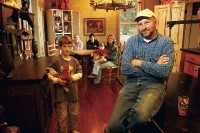 Justin Fox Burks
Justin Fox Burks
Larry Bonds and his family in their Uptown kitchen.
Local men “plant” evangelical church in Uptown.
Jordan Thomas, Bryan Smith, and Nathan Sawyer aren’t interested in building a megachurch.
Since beginning Grace Church last year, the pastors have gained a following of more than 30 members.
“That’s exceeded our expectations at this point,” Thomas says. “I honestly thought that the first several months we’d be in my living room, and it would hold what? 15?”
The living room in question is in a cozy new house on Mill, near Greenlaw Circle.
About four years ago, the trio began thinking about planting a new church. They were all from the Memphis area, having lived in West Memphis, Millington, Olive Branch, and Bartlett. Then, in 2005, Thomas attended a church-planter program in Minnesota.
“The one thing we were waiting for was another church that would bless the effort and say, hey, this seems like the Lord’s at work, not just some crazy guys,” Thomas says. “They said they would be really happy with any major city in the United States.”
The next challenge was to find a location.
“We saw how close Uptown was to the river and how close it was to the downtown population,” Smith says. “Uptown was being revitalized. Plus Midtown is right there. It became obvious to us that this is where we needed to plant.”
The trio also noted that most of the evangelical churches had migrated east, while the downtown population was rebounding.
“There are a lot of people and not many churches,” Thomas says. “I don’t know if that’s profound or not, but it was obvious.”
Even without its own building, the church has become a part of the community. Services are held at the nearby Bridges building. Over the summer, the men did a kids’ Bible study every Sunday night in Greenlaw Park, and Thomas’ house has become one of the neighborhood kid hangouts.
“I have four children,” he explains.
But for a group that isn’t interested in a megachurch, their followers are definitely following their lead. Both Smith and Thomas have moved to Uptown, and Sawyer is planning to move there. Out of the church’s 30 members, five other families have already moved into the neighborhood, as well.
“We never said we think everybody should move here,” Smith says. “They knew this was where we are going to plant and that we plan to impact the community. Part of that is moving into the community, and I think people have just felt that.”
Editor’s note: Jack Belz and Henry Turley are minority stockholders of Contemporary Media, Inc., parent company of the Memphis Flyer.
 Justin Fox Burks
Justin Fox Burks  Justin Fox Burks
Justin Fox Burks  Justin Fox Burks
Justin Fox Burks  Justin Fox Burks
Justin Fox Burks  Justin Fox Burks
Justin Fox Burks  Justin Fox Burks
Justin Fox Burks  Justin Fox Burks
Justin Fox Burks  Justin Fox Burks
Justin Fox Burks  Justin Fox Burks
Justin Fox Burks 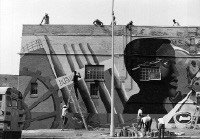
 Courtesy of Dalhoff Thomas Daws
Courtesy of Dalhoff Thomas Daws 
 Courtesy of Paradigm Productions
Courtesy of Paradigm Productions 